
The Mali Empire was an empire in West Africa from c. 1226 to 1670. The empire was founded by Sundiata Keita and became renowned for the wealth of its rulers, especially Mansa Musa. At its peak, Mali was the largest empire in West Africa, widely influencing the culture of the region through the spread of its language, laws, and customs.
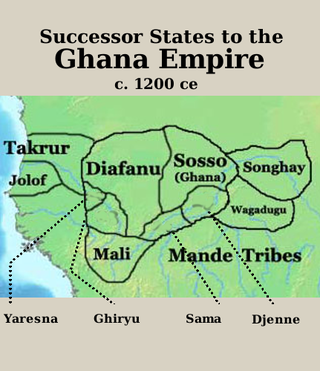
Takrur, Tekrur or Tekrour was a state based in the Senegal River valley in West Africa which was at its height in the 10th and 11th centuries, roughly parallel to the Ghana Empire, but lasted in some form into the 18th century.

The Songhai Empire was a state located in the western part of the Sahel during the 15th and 16th centuries. At its peak, it was one of the largest African empires in history. The state is known by its historiographical name, derived from its largest ethnic group and ruling elite, the Songhai people. Sonni Ali established Gao as the empire's capital, although a Songhai state had existed in and around Gao since the 11th century. Other important cities in the kingdom were Timbuktu and Djenné, where urban-centred trade flourished; they were conquered in 1468 and 1475, respectively. Initially, the Songhai Empire was ruled by the Sonni dynasty, but it was later replaced by the Askia dynasty (1493–1901).

The Songhai people are an ethnolinguistic group in West Africa who speak the various Songhai languages. Their history and lingua franca is linked to the Songhai Empire which dominated the western Sahel in the 15th and 16th century. Predominantly adherents of Islam, the Songhai are primarily located in Niger and Mali within the Western Sudanic region. Historically, the term "Songhai" did not denote an ethnic or linguistic identity but referred to the ruling caste of the Songhay Empire known as the Songhaiborai. However, the correct term used to refer to this group of people collectively by the natives is "Ayneha". Although some Speakers in Mali have also adopted the name Songhay as an ethnic designation, other Songhay-speaking groups identify themselves by other ethnic terms such as Zarma or Isawaghen. The dialect of Koyraboro Senni spoken in Gao is unintelligible to speakers of the Zarma dialect of Niger, according to at least one report. The Songhay languages are commonly taken to be Nilo-Saharan but this classification remains controversial: Dimmendaal (2008) believes that for now it is best considered an independent language family.

The Sahelian kingdoms were a series of centralized kingdoms or empires that were centered on the Sahel, the area of grasslands south of the Sahara, from the 8th century to the 19th. The wealth of the states came from controlling the trade routes across the desert. Their power came from having large pack animals like camels and horses that were fast enough to keep a large empire under central control and were also useful in such kind of battle. All of these empires were also quite decentralized with member cities having a great deal of autonomy.

Askia Muhammad I (1443–1538), born Muhammad ibn Abi Bakr al-Turi or Muhammad Ture, was the first ruler of the Askia dynasty of the Songhai Empire, reigning from 1493 to 1528. He is also known as Askia the Great, and his name in modern Songhai is Mamar Kassey. Askia Muhammad strengthened his empire and made it the largest empire in West Africa's history. At its peak under his reign, the Songhai Empire encompassed the Hausa states as far as Kano and much of the territory that had belonged to the Songhai empire in the east. His policies resulted in a rapid expansion of trade with Europe and Asia, the creation of many schools, and the establishment of Islam as an integral part of the empire.

The Bamana Empire was one of the largest states of West Africa in the 18th century. Along with Kaarta it was one of the most important successors of the Songhai Empire. Based on an earlier kingdom established in 1640, it grew into a powerful empire in the early 18th century under Bitòn Coulibaly. The empire existed as a centralized state from 1712 until the 1861 invasion by the Toucouleur conqueror El Hadj Umar Tall.

The Soninke people are a West African Mande-speaking ethnic group found in Mali, southern Mauritania, eastern Senegal, The Gambia, and Guinea. They speak the Soninke language, also called the Serakhulle or Azer language, which is one of the Mande languages. Soninke people were the founders of the ancient empire of Ghana or Wagadou c. 200–1240 CE, Subgroups of Soninke include the Jakhanke, Maraka and Wangara. When the Ghana empire was destroyed, the resulting diaspora brought Soninkes to Mali, Mauritania, Senegal, Gambia, Burkina Faso, Côte d'Ivoire, Guinée-Conakry, modern-day Republic of Ghana, Kano in Nigeria, and Guinea-Bissau where some of this trading diaspora was called Wangara.

The Sosso Empire, also written as Soso or Susu, or alternatively Kaniaga, was kingdom of West Africa that originated as a vassal of the Ghana Empire before breaking away and conquering their former overlords. Inhabited by the Soninke ancestors of the modern-day Sosso people, it was centered in the region south of Wagadou and north of Beledougou. The empire peaked under the reign of Soumaoro Kante, who was defeated by the rising Mali Empire of Sundiata Keita.

Kaarta, or Ka'arta, was a Bambara kingdom that arose after the fall of the Songhai Empire in what is today the western half of Mali and lasted until its destruction by Umar Tall in the 1850s.
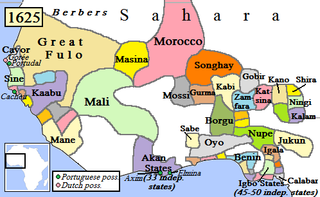
Kaabu (1537–1867), also written Gabu, Ngabou, and N'Gabu, was a federation of Mandinka kingdoms in the Senegambia region centered within modern northeastern Guinea-Bissau, large parts of today's Gambia, and extending into Koussanar, Koumpentoum, and the Casamance in Senegal.

The Empire of Great Fulo, also known as the Denanke Kingdom or Denianke Kingdom, was a Pulaar kingdom of Senegal, which dominated the Futa Toro region from the early 16th century to 1776.

Articles related to Mali include:
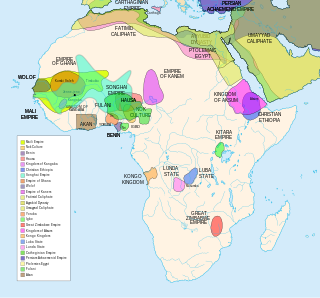
African empires is an umbrella term used in African studies to refer to a number of pre-colonial African kingdoms in Africa with multinational structures incorporating various populations and polities into a single entity, usually through conquest.
The military history of the Mali Empire is that of the armed forces of the Mali Empire, which dominated Western Africa from the mid 13th to the late 15th century. The military culture of the empire's driving force, Mandinka people, influenced many later states in West Africa including break-away powers such as the Songhay and Jolof empires. Institutions from the Mali Empire also survived in the 19th century army of Samory Ture who saw himself as the heir to Old Mali's legacy.
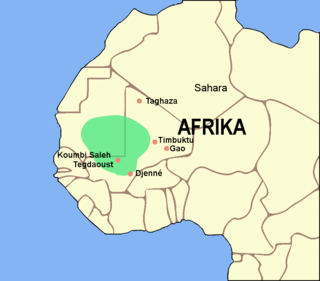
The Ghana Empire, also known as simply Ghana, Ghanata, or Wagadou, was a West African classical to post-classical era western-Sahelian empire based in the modern-day southeast of Mauritania and western Mali.
Diarra is a small town and commune in the Cercle of Nioro du Sahel in the Kayes Region of south-western Mali. In 1998, the commune had a population of 6794.
Koli Tenguella was a Fulani warrior and leader who was pivotal in establishing the Empire of Great Fulo.
Tenguella was a Fula silatigi or chief who founded a short-lived state in the upper Senegal river valley, a precursor of the Empire of Great Fulo. He was referred to as the Great Fulo or Great king of the Fulos in Portuguese documents of the time.
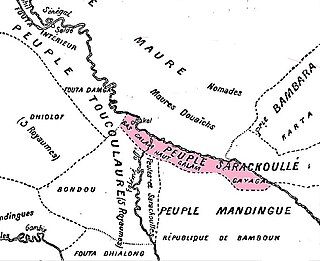
Gajaaga, also known as Galam, was a Soninke kingdom in on the upper Senegal river that existed from before 1000CE to 1858. The area today is split between Senegal and Mali. It was sometimes referred to as the Land of Gold, which it exported in large quantities, and 'Galam' in fact means 'gold' in Wolof. In the middle of the 17th century, Gajaaga was perhaps the most powerful state in the upper Senegal river region. It controlled both banks of the river from the area of Kayes downstream to Bakel.













